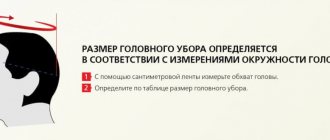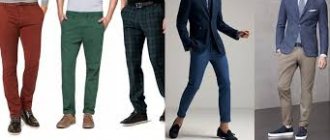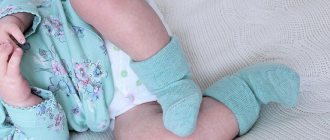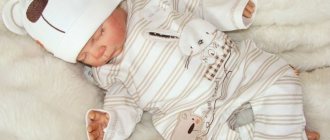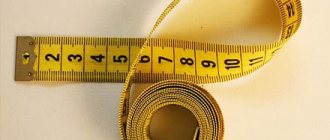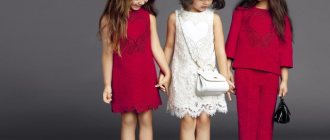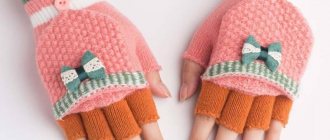“Have you put on your hat?” - this question from caring loved ones haunts us from childhood to old age. But we often shy away from this item of clothing. And not so much because we want to maintain our hairstyle, but for a much more banal reason - often a hat is simply inconvenient. For example, it fits the head too tightly, depriving the hair of its fullness and leaving red stripes on the forehead. Or, on the contrary, every now and then it tries to slide into your eyes.
Hatred for an uncomfortable hat is often born in childhood and affects one’s health. To prevent this from happening to your child, you need to learn how to choose a hat that is comfortable and most suitable for him.
Below we have collected detailed information on how to choose the size of a children's hat (as well as hats, caps, baseball caps) and what you need to pay attention to so that wearing a headdress gives your child pleasure.
How to determine the size of a children's hat
The easiest way to choose the right hat for your child is to try it on and choose the one that “fits” best. But this option only works in one case: if you buy a hat in a store, or, say, at the market.
Those who have tried online shopping at least once in their life know how unprofitable offline shopping is. A hat, cap or bonnet produced by a well-known brand, carefully tailored and made of high-quality materials, when purchased in a regular store, will cost you 3-4 times more than the same thing bought on ebay or, for example, in the online stock 6PM.
In order not to waste money, it makes sense to buy a hat, like other items of clothing, online. But how to choose the right size for a children's hat? That's how.
Traditionally, hat size is the circumference of the head, measured in centimeters.
Take a soft tailor's ribbon and wrap it around the child's head - approximately along the line along which the bottom border of the hat will "sit": above the eyebrows, over the ears (or behind them - depending on whether the headdress should cover them) and at the most convex part of the back of the head. Do not pull the flexible “centimeter”, it should lie freely!
The measured value is the size of the children's hat you need.
In the absence of a measuring tape, you can use a regular lace, which you then simply need to attach to any ruler.
What else should you consider when choosing a hat for a newborn?
The size of hats and caps is important, but it should not be the main selection criterion. The quality of tailoring and material is what is most important. When choosing a model, you should pay attention to the following nuances:
- fabric - only from natural materials, without any admixture of synthetics and stretching fibers,
- seams, especially in the back of the head, should be external and as thin as possible,
- colors are neutral, not bright, since the quality and method of coloring the material are not indicated on the products,
- style - simple, without unnecessary bows, ties and other decor,
- simple structure of the material - in the complex weaving of threads, the remains of the baby’s drool, breast milk and washing and rinsing products can accumulate.
In addition, you cannot buy hats for little ones, even if the size of the hat corresponds to the size of a newborn’s head, in markets and in unverified retail outlets. This should be done in specialized stores. It is necessary to pay attention to the integrity of the factory packaging and the cleanliness of the cap that you are going to buy for your baby.
Under no circumstances should you try on something new without first washing and ironing it, even “for a second.” The skin of newborns is very delicate, it is easily injured, it reacts sharply and violently to any allergens, viruses and bacteria. Parents must understand that clothes, even for the little ones, are not sewn in sterile conditions, but in ordinary workshops of clothing factories.
Equally close attention should be paid if hats for newborns are ordered from an online store. A responsible resource always provides the opportunity to inspect children's products upon receipt, return and exchange. In an online store, as in a regular store, there must be certificates for children's items - hats and bonnets, baby vests and rompers, diapers and bed linen.
All the rules for sizing and choosing hats for babies from their first birthday to one year described above can be safely applied when purchasing everyday and holiday hats, caps and hats. Even if you are looking for an option for one “outing” for your child, for his christening or “anniversary”, the baby will only stay there for an hour and a half or a few minutes, you need to be as careful as possible in your choice. The health, comfort and safety of the child depends on your fleeting and seemingly insignificant decisions.
Children's hat size chart
Size in centimeters is the most accurate, but not the only way to “measure” a headdress. Manufacturers often indicate the age of the child as the hat size - for example, 3-5 years, or 7-9.
In principle, this is also true: such hats will fit perfectly on an average child of the appropriate age. But if your child develops at an individual pace and is ahead of his peers in size (or, on the contrary, is behind them), this must be taken into account and choose a hat designed for a slightly older (less) actual age.
To avoid confusion, we have compiled a table of sizes, indicating in it the correspondence between traditional sizes in centimeters and in the “age” and “height” formats.
| Hat size | Head circumference (cm) | Height (cm) | Age |
| 56–58 | 58 | 146–152 | 12 years |
| 56–57 | 57 | 140–146 | 11 years |
| 56 | 56 | 134–140 | 10 years |
| 56 | 56 | 128–134 | 9 years |
| 55 | 55 | 122–128 | 8 years |
| 54 | 54 | 116–122 | 7 years |
| 53 | 53 | 110–116 | 6 years |
| 52 | 52 | 104–110 | 5 years |
| 51 | 51 | 98–104 | 4 years |
| 50 | 50 | 92–98 | 3 years |
| 49 | 49 | 86–92 | 2 years |
| 48 | 48 | 80–86 | 1.5 years |
| 47 | 47 | 74–80 | 12 months |
| 46 | 46 | 68–74 | 9 months |
| 44 | 44 | 62–68 | 6 months |
| 40 | 40 | 56–62 | 3 months |
| 35 | 35 | 50–54 | newborn |
Size tables
A table based on age will help you determine the size of a hat for children. The label may indicate additional parameters - height and head circumference, but this is not a prerequisite.
Size chart for babies up to one year:
| Marking | Age, months | Height, cm |
| 35 | 0-2 | 49-55 |
| 40 | 3 | 55-63 |
| 44 | 6 | 61-69 |
| 46 | 9 | 67-75 |
| 47 | 12 | 75-80 |
Size chart for children over one year old:
| Marking | Age, years | Height, cm |
| 48 | 1,5-2 | 80-88 |
| 49 | 2-3 | 86-92 |
| 50 | 3-3,5 | 92-98 |
| 51 | 3,5-4 | 98-104 |
| 53 | 5-6 | 108-116 |
| 54 | 6-7 | 110-122 |
| 55 | 7-8 | 116-128 |
| 56 | 9-10 | 128-140 |
| 57 | 10-12 | 134-150 |
| 58 | 12-14 | 146-152 |
Some manufacturers use an international marking system, indicating the size of children's hats with letter symbols.
| Head circumference, cm | International hat size |
| 40-44 | XXS |
| 43-47 | XS |
| 46-49 | S |
| 49-52 | M |
| 52-54 | L |
| 54-58 | XL |
Author:
Zakharova Nina Afanasyevna
I hope you like my article! If you find any shortcomings, just write to me about it! I am always ready for a conversation and will answer any questions you have, ask them!
